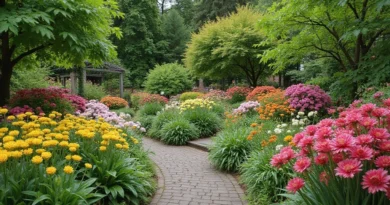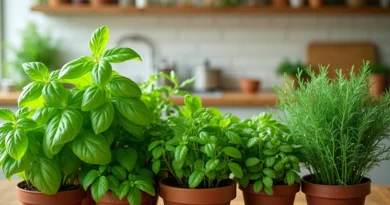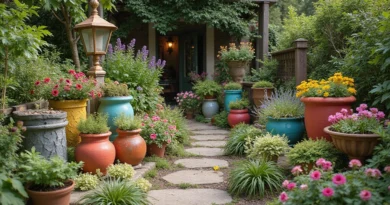Pro Tips for Designing Stunning Garden Pathways: Enhance Your Outdoor Space
A beautiful garden pathway can be the perfect way to tie together the various elements of your garden, leading the eye and feet through a delightful landscape.
The right pathway not only enhances accessibility but also adds charm and character to your outdoor space. With so many options for design, style, and materials, it’s crucial to make choices that reflect your personal style and the overall aesthetics of your garden.
Let’s explore some pro tips to help you craft stunning garden pathways that will have your neighbors admiring your outdoor oasis.
1. Choose the Right Materials

The materials you select for your garden pathways can dramatically affect the overall look and feel of your garden. From rustic wooden planks to sleek modern concrete, each material has its own charm.
Consider using natural stone for a timeless look, or gravel for a casual, laid-back vibe. Brick paths can offer a classic feel with a touch of elegance, while decomposed granite provides a unique texture.
When picking, think about durability and maintenance. For example, wooden paths may require more upkeep than stone or gravel. Balancing aesthetics with functionality is key.
• Natural Stone: Durable and visually appealing, great for formal gardens.
• Gravel: Budget-friendly and easy to install, allowing for good drainage.
• Brick: Adds a classic touch and can be arranged in various patterns.
• Concrete: Versatile and can mimic other materials, perfect for modern settings.
Choosing the right materials sets the foundation for the entire pathway design.
2. Define Pathway Width

The width of your garden pathway is more than just a practical consideration; it’s a vital design element that influences the overall flow of your garden.
Narrow pathways work well in smaller gardens, giving a cozy feel, while wider paths can create a more grand and open ambiance. A width of at least three feet is often recommended for accommodating foot traffic comfortably, especially if you plan to use garden tools or furniture along the way.
Consider the purpose of your pathways. Will they primarily guide visitors? Or will they serve as a functional passage for maintaining your garden?
• For pedestrian traffic: 3-4 feet is ideal.
• For garden equipment: 4-5 feet provides ample space.
• Visual appeal: Experiment with tapering paths for a whimsical touch.
Defining the pathway width helps to create an inviting journey through your garden, balancing function and aesthetics.
3. Incorporate Edging

Edging is an essential technique for garden pathways, serving both practical and aesthetic functions. It helps to define the path’s boundaries, keeps the materials in place, and prevents grass or weeds from encroaching.
Using materials like bricks, stones, or even wood can enhance the visual appeal of your pathway. Moreover, edging can create a clean, manicured look that elevates the overall design.
Soft curves or sharp lines in edging can guide the eye and make your garden feel more cohesive.
• Brick or stone edging provides a classic, formal appeal.
• Wood can offer a rustic touch, perfect for country-style gardens.
• Metal edging is sleek and modern, adding a contemporary twist.
By incorporating edging, your garden pathways will not only look fantastic but also function effectively.
4. Add Lighting for Ambiance

Lighting can transform your garden pathways into enchanting routes, especially during nighttime. Subtle lighting can enhance safety, guiding visitors through your outdoor space while creating a warm, inviting atmosphere.
Consider using solar-powered lights, which are eco-friendly and easy to install. String lights or lanterns add a whimsical touch, perfect for cozy evening gatherings.
• Solar path lights: Affordable and energy-efficient.
• Fairy lights: Create a magical ambiance when draped over trees or along fences.
• Spotlights: Highlight key features along the pathway.
Strategically placing lights along the pathway not only beautifies your garden but also creates a safe navigational route after dark.
5. Use Natural Curves

Natural curves soften the geometric lines of a garden pathway, making it feel more inviting and organic. Rather than a straight shot from point A to B, gentle curves can mimic the flow of nature, creating a more tranquil experience.
Curved paths can lead guests through interesting garden features, inviting them to pause and explore. Additionally, they can help to maximize space in smaller areas.
• S-shaped paths can make long runways feel shorter.
• Incorporate plants or boulders along the curves for visual interest.
• Use smaller stones to form a winding path that appears more natural.
By incorporating natural curves, you allow your garden pathways to blend seamlessly into the environment making your outdoor space feel larger and more open.
6. Consider Functional Additions

Functional features can enhance your garden pathways, making them not just beautiful but practical too. Think about adding benches or seating areas along the way, allowing for rest and reflection.
Incorporating planters or decorative pots can also add life and vibrancy to your path, creating focal points that draw the eye. Built-in lighting or water features can elevate the experience further.
• Benches provide a comfortable stop for enjoying the view.
• Planters can be arranged for seasonal blooms.
• Small fountains or birdbaths can enhance the sensory experience.
Adding these functional elements transforms pathways into destinations, making your garden a more inviting and engaging space.
7. Create Texture with Layering

Texture adds depth and interest to garden pathways, making each step a tactile experience. Layering different materials can create a unique look and feel. For instance, combining gravel with flat stones or mixing brick with grass can enhance visual interest.
Consider using a variety of plant life to line your pathway, adding a soft, lush texture that contrasts with hard materials.
• Layer gravel under stepping stones for a rustic appeal.
• Combine smooth stones with rough-hewn wood for facial contrast.
• Utilize different plant textures, like ferns and succulents, to create lively borders.
By creatively layering materials and plants, you can transform ordinary pathways into stunning outdoor features.
8. Plan for Seasonal Changes

Seasonality plays a vital role in garden design, and pathways should be planned with this in mind. Choosing plants that bloom at different times of the year ensures your garden remains vibrant throughout the seasons.
Decide on materials that can withstand various weather conditions. For example, permeable materials allow rainwater to drain, reducing puddles and keeping the path safe during rainy seasons.
• Select hardy plants that thrive in your local climate.
• Incorporate evergreen plants for year-round greenery.
• Plan for seasonal changes in color, like using fall foliage or spring blooms.
A pathway designed with seasonal changes in mind will ensure your garden is always inviting, no matter the time of year.
9. Personalize Your Design

Your garden pathway reflects your personality, so don’t shy away from decorating it to suit your taste! Adding personal touches can make your outdoor space feel uniquely yours.
Consider using mosaic tiles, custom artwork, or sculptures along the path to create a more personalized experience. Handmade stepping stones or painted rocks can also serve as wonderful conversation starters.
• Use colors that resonate with your style, from bright mosaics to earthy tones.
• Incorporate art that reflects your interests, like wildlife or abstract designs.
• Add whimsical elements, such as birdhouses or wind chimes, to infuse character.
Personalizing your pathway allows you to express your creativity, making each stroll a delightful journey.
10. Maintain Your Pathway

Once your garden pathway is completed, maintaining its beauty is essential for longevity. Regular upkeep can prevent overgrowth, erosion, and damages from weather.
Plan for seasonal maintenance, such as clearing debris, refreshing mulch, and replanting as necessary. Regularly check for loose stones or shifting bricks and make adjustments as needed.
• Schedule seasonal clean-ups to remove leaves and debris.
• Replenish gravel or mulch where needed.
• Assess plant life for health and vitality, removing any dead or overgrown plants.
A well-maintained pathway not only looks good but also ensures safety and durability for years of enjoyment.
Conclusion

Designing stunning garden pathways is all about blending function with aesthetic appeal. By using these pro tips, you can create pathways that not only guide visitors through your outdoor space but also reflect your personal style and taste.
From selecting the right materials to personalizing your design, each aspect contributes to a beautiful garden experience. Consider these insights as you embark on your gardening journey—your perfect pathway awaits!



